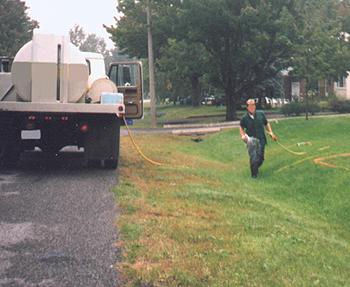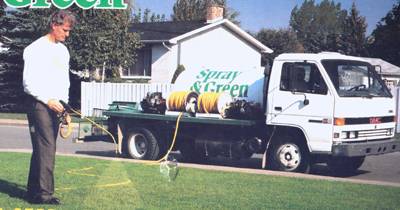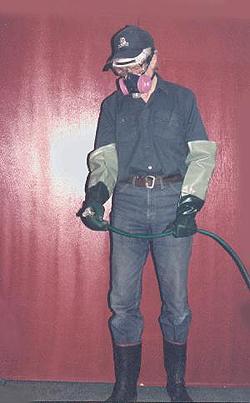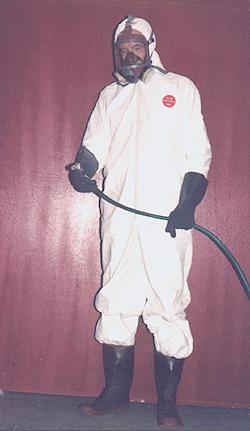(The photo has been modified to remove personal identification. This could have been any local company before the provincial cosmetic pesticide ban.)

Since 1988, Health Canada has had a Workplace Hazardous Materials Information System (WHMIS), which has the aim of protecting people who must work with chemicals that might endanger their health. However, at the time of the introduction of WHMIS, pesticides were controlled by Agriculture Canada, who successfully lobbied cabinet to exempt all pesticides from the Health Canada program. Although the actual fight was about bureaucratic turf, the result was that the government decided that agricultural production was more important than the health of Canadians.
| Here was the result: a typical scene on a public street in Ottawa - a worker spraying a mix of chemicals all over
a lawn. No gloves. No vapour inhalation protection. No eye protection. And, obviously, no knowledge.
(The photo has been modified to remove personal identification. This could have been any local company before the provincial cosmetic pesticide ban.) | 
|
| Here was another result - an advertisement for a spray company that sold its products in retail stores all over Ontario with no Pesticide Registration Product Act registration, and no WHMIS symbols anywhere on the package or in the instructions. | 
|
| The workers could have been spraying just 2,4-D, one of the less toxic pesticides. If they had been, this is the safety equipment they should be wearing, according to Labour Canada's Canadian Center for Occupational Health and Safety: rubber boots, chemical-resistant gloves, eye-splash protection, and air-purifying respirator. This is also the safety equipment shown in the Health Canada pamphlet "Pesticide Use in and Around the Home". | 
|
| But, lawn care mixes commonly contained much more dangerous things than 2,4-D: insecticides such as chlorpyrifos or fungicides such as benomyl. One of the Spray&Green mixes does contain chlorpyrifos. So, the workers shown need more protection than for 2,4-D according to the CCOHS, in particular: clothing impermiable to the pesticide and its solvents (such as the light weight Tyvec® suit shown here) and chemical workers' goggles or a full-face respirator. And, monitoring of sprayers' blood cholinesterase levels. | 
|
How often did we see even the minimal gear in the middle photo? Never, and particularly never in company brochures or in ads. In fact, at least one major company fired anyone who even tried to wear a dust mask when applying their pesticides. Protective gear might make customers realize how dangerous the chemicals are that were being spread all over their property. And, it might have made the worker demand pay commensurate with the risk, or look for a safer job.
The last, of course, is precisely what WHMIS was set up for - to protect the health of Canadian workers. And it is that protection that was denied all those who worked with pesticides by the exemption of pesticides from WHMIS.
Finally, long since the writing of this page, the federal government accepted the demand of a parliamentary committee that Canadian pesticides be provided with MSDS sheets. But, these data sheets are still produced and controlled by the pesticide industry through Health Canada's PMRA, not directly through the impartial and respected WHMIS process. Secret ingredients are still protected from disclosure, no matter how toxic they are.
Pesticides are substances designed specifically for the purpose of killing living things. Why did Health Canada refuse Canadians the right to any knowledge of their dangers until Parliament forced them to? And, why do they still value pesticide 'trade secrets' over the health of Canadians?
John Sankey
other notes on pesticides
I thank BLR Safety & First Aid for the loan of the safety equipment shown in the photos.